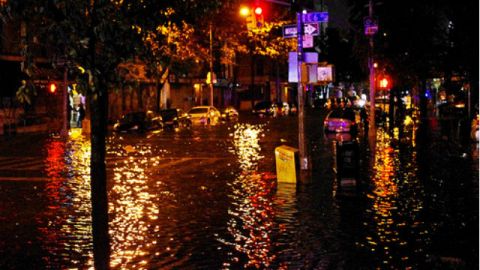New Yorkers Celebrate Trees with NYRP

Thursday night was an especially chilling Halloween for New Yorkers. We remember well the heartbreaking, senseless deaths of Sandy. The killer storm strained resources across the five boroughs, and plunged half of Manhattan into darkness. Sandy was a disturbing wake-up call that if it could happen here, it could happen anywhere.
With global warming, our weather is only going to become deadlier.
That’s why this year the New York Restoration Project, a mainstay organization responsible for planting nearly one million trees in the city and building community gardens in high need neighborhoods, held its 18th annual Hulaween fundraiser in the Waldorf Astoria in honor of New Orleans. Politically-themed costumes included a FEMA worker, do-nothing Congressional members turned into voodoo dolls, and Democratic mayoral candidate Bill DeBlasio’s two children made famous by campaign TV ads—Chiara and Dante, and Mayor Michael Bloomberg himself who claimed to be dressed as George Clooney. Founder Bette Midler opened the evening by recalling “that fiend Sandy,” and honoring Bloomberg on stage, whom she repeatedly praised as “the city’s greenest mayor.” Midler joked that, given the upcoming mayoral election, she didn’t yet know who to kiss up to next.
Though Sandy wasn’t nearly as devastating as Katrina, the message was clear that New York and New Orleans are now united in solidarity. It raised the question: which city will be next?
What other innocuous name will identify just how vulnerable we are to Mother Nature, especially when her climate has been messed with?
Hurricane season used to be something reserved for the South. Like earthquakes and California, it wasn’t something that applied to us. Now, every hurricane season, New Yorkers will hold their breath. We will continue to wonder, will there be another blackout and more flooding? More infuriating headlines about the lights going out in a hospital but staying on in Goldman Sachs?
Even recent research, promising that killer storms, though on the rise, will likely not take the same path that Sandy did, is of no comfort to us. When you’re dealing with extreme weather brought on by man-made climate change, how predictable can these storms be? In 2011, Hurricane Irene was supposed to slam into the city, causing evacuations of low-lying neighborhoods. Instead, Irene missed New York City and washed away houses in the Catskills.
Organizations like the NYRP are particularly vulnerable. NYRP recently made headlines, including here on Big Think, for getting close to completing their goal of planting 1 million trees in New York City. Our beloved trees are on the frontlines of fighting climate change. Carbon dioxide is a major greenhouse gas, and trees absorb this stuff, keeping it out of our atmosphere. We need more trees! But the irony is that these killer storms are just too good at uprooting and felling them.
Sandy knocked down tens of thousands of trees and damaged community gardens that breathe life into this concrete jungle. To fight back, the NYRP has been trying out new flood resistant technology at their neighborhood garden in Carroll Gardens, near the flood risk of the superfund site that is the eerie green Gowanus Canal. In their Rockaway community garden, in a neighborhood on the coast that was one of the hardest hit, the garden is still being rebuilt in a collaborative effort led by green-thumbed locals. But it just takes another killer storm to uproot all this hard work.
So what can we do while we’re stuck with a gridlocked Congress and a politicized debate still arguing man-made climate change? (President Ronald Reagan famously blamed trees for causing pollution—“more pollution than automobiles”—remember that fun piece of trivia for your next cocktail party.) Should we just continue to plant more climate-change fighting trees, have the next killer storm knock them down, and plant again? Yes, because the more trees that are planted, the further ahead we are of the storm. Sandy brought down 30,000 trees; over the years, the NYRP has planted around 800,000. The more we can support organizations like this one, the more the numbers are on our side.





